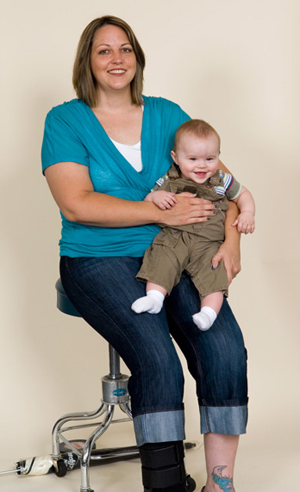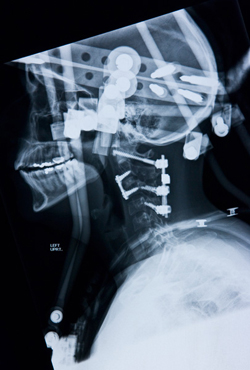It’s not everyone who sees a badly broken leg as a gift from God. Especially not when it was shattered by an oversized pickup truck driven by a drunk driver who ran a stop sign, T-boned your car and bulldozed you into a ravine.

Because of the quick and excellent work of John C. Lincoln’s Level I Trauma Center team, Ronica Mayer is able to enjoy her beautiful, happy baby, Seth Jr.
And most especially not when the crash interrupted your much-anticipated trip to meet your husband for your first official “date” after your baby’s birth.
Most folks would consider that sequence really bad luck, especially after a day that had begun so well.
Ronica Mayer’s beautiful, cooing, happy baby, Seth Jr., was three weeks old that day in December. She had just dropped him off with mother-in-law Diann Mayer, where he joined older sisters Annie, 12, and Elise, 11, for a party at grandma’s house, six-miles down New River Road from their own rural home. That gave Ronica, 34, and husband Seth, 32, time for their first post-baby dinner date.
“I was really happy,” Ronica said. “My husband was finishing church band practice, and I was driving the speed limit, about 45 mph, down the road. I was just a mile from home when this huge pickup truck blew a stop sign and hit me broadside. There was nothing I could do. He knocked my little car into the boulders at the bottom of the ravine.
“At first I thought I could get out,” she said, “but I couldn’t move my leg. So I just waited for help.”
Ronica has no doubt that her injured leg was God’s grace. “If my leg hadn’t been broken,” she explained, “I would have crawled out of the car, because I didn’t know my neck was also broken. And if I’d done that, I might be paralyzed or dead right now.”
Because her leg injury kept her from moving, she stayed inside her crumpled little car until the paramedics from Daisy Mountain Fire Department stabilized her neck, extricated her ever so carefully and carried her gently out of the New River Road ravine into their waiting ambulance.
But nobody knew Ronica’s neck was broken until Daisy Mountain delivered her to the John C. Lincoln Deer Valley Hospital Emergency Department, where medical images revealed fractures in both her C2 and C3 neck bones. C2 also was dislocated. That means her fragile spinal cord was unprotected and extremely vulnerable.

Ronica’s X-ray reveals Dr. Gianni Vishteh’s surgical remedy and the “halo” that was attached to her skull to immobilize her neck.
“She had what is called an ‘unstable hangman’s fracture,’ the kind of injury criminals would sustain when executed by hanging,” explained Ronica’s neurosurgeon, Gianni Vishteh, MD, chairman of John C. Lincoln’s Section of Neurosurgery. “She easily could have been paralyzed.”
Ronica was whisked from Deer Valley to John C. Lincoln’s Level I Trauma Center at the North Mountain Hospital, where she met Dr. Vishteh and the rest of the trauma team.
“They were all so amazing,” Ronica said. “I was blessed with the best of the best. I just cannot say enough good things about the people who took care of me at John C. Lincoln. Dr. Vishteh also took care of another lady at my church. We call him our rock star. He’s that good.”
Ronica had a lot of positive things going for her when she reached the Trauma Center, Dr. Vishteh explained. “She had good strength in her arms and in her unbroken leg. She could wiggle her toes. Those were good signs and made it more imperative to immediately immobilize her to prevent further damage.”
Ronica was surgically attached to a “halo,” a device that immobilizes the neck via a head ring and pins that are bolted into the skull. The ring, in turn, is attached to a vest via four posts. Then Dr. Vishteh went to work on the delicate, intricate two-stage surgery that pieced Ronica back together.
“First we approached the injury from the front to realign the vertebrae in her neck, remove the disc between C2 and C3, to perform a fusion with allograft bone and fixate with a plate,” Dr. Vishteh recalled. “In the second stage, we tackled the injury from the back of the neck, which meant Ronica had to be flipped.”
Because in a number of cases like Ronica’s, the patient’s surgery requires a posterior approach, the halo is indispensable in preventing further spinal cord injury during positioning, Dr. Vishteh stressed.
Ronica has a neat vertical scar down the back of her neck from her hairline to her collar, which is where Dr. Vishteh worked to place screws, dual rods and a crosslink to fixate from C1 to C4. He also harvested a bit of Ronica’s own hipbone to fuse the bone from the posterior side.
Dr. Vishteh noted that the posterior cranio-vertebral junction, the point where the head sits on the neck, was once a “no man’s land” for surgical instrumentation. It just wasn’t done.
“Advances in technique and instrumentation, however, now allow us to perform these kinds of surgeries,” he said. Dr. Vishteh, who has extensive experience in managing these problems, is quick to point out that in spite of these advances, a thorough anatomical knowledge of this vulnerable area is crucial to prevent devastating neurovascular injuries.
“Ronica’s second stage surgery went very well,” Dr. Vishteh said. But even though his work in the operating room was done, he stayed close to watch over Ronica.
Dr. Vishteh was just as compassionate to Ronica’s husband, she said. “Seth was a mess while I was in surgery,” Ronica said. “He was just devastated. When Dr. Vishteh came out, he asked what the odds were that I might recover. Dr. Vishteh told him there were no odds. He said I was going to be just fine. That meant everything to my husband.”
And it wasn’t just the doctor who was good. “I remember one day one of the nurses washed my hair for me and braided it,” Ronica said. “She treated me like more than a patient, like her own family. She was so nice. And Randy and Ella in physical therapy were so loving and supportive. Everyone was!”
Ronica was in ICU for six days and in the orthopedic unit for another five. After her neurosurgery was complete, orthopedic surgeon Dan Heller, MD, took her back to the OR to fix her leg, which has had a few complications. Her tibia, the larger of the two lower leg bones, developed an infection, which significantly slowed the healing process.
She spent three weeks in a skilled nursing facility after leaving the hospital. “It was a humbling experience,” Ronica said. “I have a family and I’m used to taking care of myself and doing for others. But I was helpless – I couldn’t wash my hair or brush my teeth. It is amazing that people are given the ability to care for others the way they cared for me.”
It’s been a long, slow recovery. But seven months after her crash, she “graduated” from her wheelchair to a walker and became able to pick up and carry little Seth, who’s getting bigger and more active by the day. “He’s got such a great disposition – he loves everyone. He’s another blessing in my life.”
Ronica looked forward to returning to work at Childhelp, a center for abused and neglected children. “They’re holding my job for me!”
Visit JCL.com/trauma, for more information about trauma services.